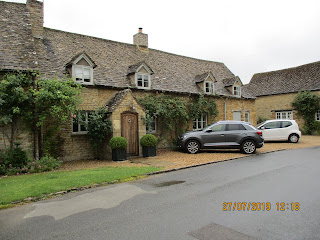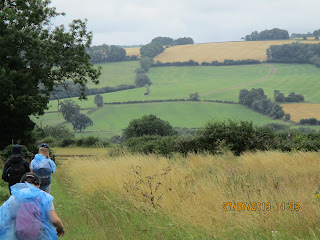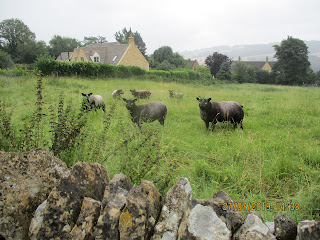Day 3:
We stayed in the Crosshands campsite by the Greedy goose pub in a hut.
We loved it.
As you can see the ponchos are out.
We are expecting a wet day.
But nothing will stop us !
As we cross the road A44 (green on the map),
we came in Gloucestershire.
Just before the cattle grid we met one cow.
I convince William to walk behind me.
This will be the beginning of many interference with cattle !!
...and horses
walking down to Chastelton
where Chastleton House is open for visit,
A rare gem of a Jacobean country house,
Chastleton House was built between 1607 and 1612
by a prosperous wool merchant
as an impressive statement of wealth and power.
The National Trust own this property since 1991.
As we go threw the Cotswold we will often see
that "impressive statement of wealth and power"
shown by the wool merchant.
When you walk you have the privilege to see
all sorts of animals that you wouldn't see in a car.
If you look carefully you can see a reindeer below.
Apart of cows, horses and sheep which we saw in large amount,
we also saw a lama, swans, small ostrich,
rabbit, beetle, light green grasshopper ...
rabbit, beetle, light green grasshopper ...
Still on track.
We will none again pass a disused railway along the Macmillan way.
This sign used to be for Adlestrop station.
This is a poem fixed on the chair at the bus stop
made by Edward Thomas,
Philip Edward Thomas (1878–1917)
was a British poet, essayist, and novelist.
He is commonly considered a war poet,
although few of his poems deal directly
with his war experiences, and his career in poetry only came after
he had already been a successful writer and literary critic.
In 1915, he was killed in action during the Battle of Arras in 1917.
The Old Rectory
often visited by Jane Austen, where her uncle lived.
Jane Austen (1775-1817)was an English novelist
known primarily for her six major novels,
-Sense and Sensibility (1811), Pride and Prejudice (1813),
Mansfield Park (1814) and Emma-
which interpret, critique and comment upon the British landed gentry
at the end of the 18th century.
Austen's plots often explore the dependence of women on marriage
in the pursuit of favorable social standing and economic security.
We will go threw lovely Lower Oddington village.
We took a slight diversion to see a church pointed as a point of interest.
St Nicholas church, 13th & 14th century building.
We took shelter in its entrance to have our lunch.
Change ringing(see photo below) is the art of ringing a set of tuned bells
in a controlled manner to produce variations in their striking sequences.
This creates a form of bell music which cannot be discerned
as a conventional melody.
The bells in a tower reside in the bell chamber or belfry
usually with louvred windows to enable the sound to escape.
We then go back where we left our path and
enter a field of cows.
Closer to the gate the cattle is gathered in front of it.
This will be one diversion among many many more !!
Edward made us go in the next field and climb over barbwire.
We finally found our way into Upper Oddington.
Look closely !
This is not a traditional English telephone box.
Seen very often in villages threw the Cotswold,
those telephone box keep a Defibrillator.
After walking for a while along the main road B4450,
where I insist for the front boy to wear a safety yellow vest,
we will then follow a winding road to Maugersbury,
a pleasant village with lovely views across valley Icomb.
we won't visit Stow-on-the-Wold this time which is just up the road.
Stow-on-the-Wold is a market town,
on top of an 800 ft hill, at the junction of major roads
through the Cotswolds.
The town was founded by Norman lords
to take advantage of trade on the converging roads.
It is a very touristic town nowadays.
In my research I have found that amusing couplet:
"Stowe-on-the-Wold, Where the wind blows cold.
Where horses young and old are sold,
Where farmers come to spend their gold.
Where men are fools and women are bold
and many a wicked tale is told.
High on the freezing Cotswold."
We are crossing the busy A429 road with great care and
follow a private smaller road.
The signs tell us to go right (on photo above),
my Macmillan book tells me to go straight.
We take straight on !
Hyde Mill House
All we have to do now is follow the river Dikler.
We arrive in Lower Slaughter, a typical Cotswold village,
built on both bank of the River Eye.
It's also very touristic.
This is not my photos but it gives you a better idea how pretty is that village.
This is where we meet Steve (my husband) to give us a lift
to our accommodation for the next 2 nights, Folly farm campsite.
And as he's not there yet, we take shelter in the local Pub,
the Slaughters Country Inn
the Slaughters Country Inn
We will stay 2 nights in Folly farm campsite,
Saturday & sunday night.
Steve will be our chauffeur morning & evening
to take us where we stopped the day before.
And where the boys can run after the football at night.
We walked an impressive 18.6km on our 3rd day.












































No comments:
Post a Comment